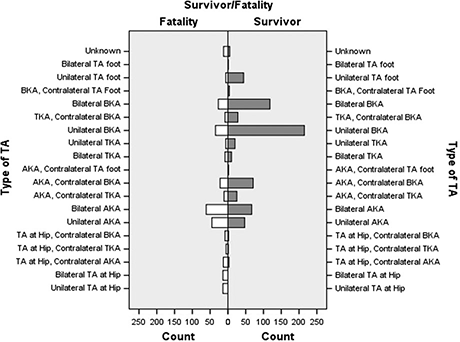Lower extremity traumatic amputations have been a prominent blast injury in both modern and past conflicts involving explosive weapons. This type of blast injury has historically been associated with high mortality rates; however, advances made during recent conflicts in Iraq and Afghanistan (e.g., evacuation times, tourniquet use) have reduced the percentage of those killed in action (KIA) by more than a third. Despite these advances almost a quarter of deaths on the battlefield are still considered "potentially survivable."
To continue improving prevention and mitigation strategies for lower extremity traumatic amputations a deeper understanding of this injury pattern is needed, including knowledge about the levels of amputation, their frequency, and outcomes. To address this need, researchers at the Centre for Blast Injury Studies (CBIS) at Imperial College London have analyzed a large cohort of traumatic amputations caused by blast to understand the relationship between amputation levels and associated injury characteristics with risk of mortality.
The CBIS researchers interrogated the UK Joint Theatre Trauma Registry (JTTR) to identify lower extremity traumatic amputations sustained in Iraq and Afghanistan between January 2003 and August 2014. The JTTR database contains both military and non-military casualties either admitted to UK medical facilities or killed during deployment. They identified 977 casualties who sustained a total of 1,471 lower extremity traumatic amputations. Of the 977 casualties, there were 679 (69.5 percent) survivors and 298 (30.5 percent) fatalities, and of the fatalities, 206 (70 percent) were KIA and 89 (30 percent) died of their wounds after medical intervention was possible.
A deeper look at the data showed that casualties who sustained bilateral amputations had a significantly higher mortality rate (35.9 percent) compared to those with unilateral amputations (25.5 percent), and more proximal amputations were associated with overall higher mortality rates (see Figure). Casualties with an associated abdominal injury or pelvic fracture had higher mortality rates compared to those casualties without. In addition, although pelvic fractures occurred significantly more often in casualties with bilateral versus unilateral lower extremity amputations, they occurred across the different types and levels of traumatic amputation and could not be defined to one particular pattern of lower extremity injury.
The study from CBIS is the largest analysis of combat-related traumatic amputations to date and sheds new light on this injury pattern, its characteristics, and ways to improve survivability. The study confirms the high mortality rate for traumatic amputations of the lower extremity, and extends the knowledge base in several important ways. First, the study demonstrates that proximal amputations correlate with increased mortality. This finding makes sense in light of current limitations for battlefield hemorrhage control – the standard tourniquet becomes more difficult to apply as the injury approaches the thigh and hip. Second, associated pelvic fractures and abdominal injuries correlate with increased mortality. This finding implies that efforts to prevent or mitigate the extension of lower extremity injuries to the pelvis and abdomen will increase survival rates.

Webster, C. E., Clasper, J., Stinner, D. J., Eliahoo, J., & Masouros, S. D. (2018). Characterization of Lower Extremity Blast Injury. Military medicine, 2018 Mar 14.
Your 15 minute session will timeout in approximately 10 minutes.
If you're in the middle of entering information, please close this warning and save your progress (if possible) or finish up your task.
If your session fully times out, you will lose any un-saved work.
Your current Blast Injury Research Program session has expired.
Your next click will take you away from the private area, and you will lose any work you have in-progress.
Please enter your email address, and try again.